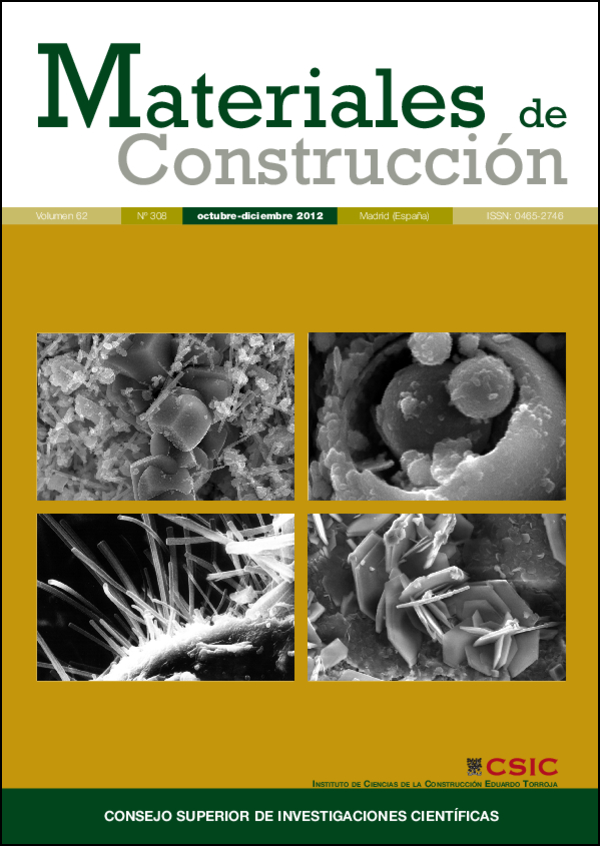Quantification model for energy consumption in edification
DOI:
https://doi.org/10.3989/mc.2012.02411Keywords:
steel, agregates, concrete, wod, ceramic, gypsumAbstract
The research conducted in this paper focuses on the generation of a model for the quantification of energy consumption in building. This is to be done through one of the most relevant environmental impact indicators associated with weight per m2 of construction, as well as the energy consumption resulting from the manufacturing process of materials used in building construction. The practical application of the proposed model on different buildings typologies in Seville, will provide information regarding the building materials, the subsystems and the most relevant construction elements. Hence, we will be able to observe the impact the built surface has on the environment. The results obtained aim to reference the scientific community, providing quantitative data comparable to other types of buildings and geographical areas. Furthermore, it may also allow the analysis and the characterization of feasible solutions to reduce the environmental impact generated by the different materials, subsystems and construction elements commonly used in the different building types defined in this study.
Downloads
References
(1) Zabalza Bribián, I.; Valero Capilla, A.; Aranda Usón, A.: "Life cycle assessment of building materials: Comparative análisis of energy and environmental impacts and evaluation of the eco-efficiency improvement potencial", Build. Environ., vol. 46 (2011), pp. 1133-1140. http://dx.doi.org/10.1016/j.buildenv.2010.12.002
(2) Wadel, G.: "La sostenibilidad en la construcción industrializada. La construcción modular ligera aplicada a la vivienda". Tesis doctoral. Universidad Politécnica de Cataluña, departamento de construcciones arquitectónicas, (2009). http://www.tdx.cat/TDX-0122110-180946.
(3) Mercader, Mª P.; Marrero, M.; Solís, J.; Montes, Mª. V.; Ramírez de Arellano, A.: "Cuantificación de los recursos materiales consumidos en la ejecución de la cimentación", Inf. Constr., vol. 62, nº 517 (2010), pp. 125-132.
(4) Wadel, G.; Avellaneda, J.; Cuchí, B.: "La sostenibilidad en la arquitectura industrializada: cerrando el ciclo de los materiales". Inf. Constr., vol. 62, nº 517 (2010), pp. 37-51.
(5) Cuchí, A.; Wadel, G.; López, F.; Sagrera, A.: Guía de la eficiencia energética para administradores de fincas, p. 148, 1ª edición Fundación Gas Natural, España (2007).
(6) Goldenberg, J.: Energía, medio ambiente & desenvolvimiento. Sao Paulo. Edusp (1998).
(7) Webb, R.: "Building insulation for sustainability-guideline and standards". Proceedings of international conference sustainable building, Oslo, Norway (2002).
(8) Edwards, B.; Hyett, R.: Rough guide to sustainability. London: RIBA Enterprises (2001).
(9) González, Mª. J.; García Navarro, J.: "Assessment of the decrease of CO2 emissions in the construction field through the selection of materials: Practical case study of three houses of low environmental impact". Build. Environ., vol. 41 (2006), pp. 902-909. http://dx.doi.org/10.1016/j.buildenv.2005.04.006
(10) Khasreen, M.; Banfill, P.; Menzies, G.: "Life-cycle assessment and the environmental impact of buildings: a review". Sustainability, vol. 3 (2009), pp. 674-701. http://dx.doi.org/10.3390/su1030674
(11) Kellenberger, D.; Althaus, H-J.: "Relevance of simplificatios in LCA of building components", Build. Environ., vol. 44 (2009), pp. 818-825. http://dx.doi.org/10.1016/j.buildenv.2008.06.002
(12) Mercader, Mª P.: "Cuantificación de los recursos consumidos y emisiones de CO2 producidas en las construcciones de Andalucía y sus implicaciones en el Protocolo de Kioto". Tesis doctoral. Universidad de Sevilla, vol. 1 (2010), pp. 119-123. http://fondosdigitales.us.es/tesis/
(13) ICARO/CTAV. 100 Materiales Sostenibles. Valencia: Colegio Territorial de Arquitectura de Valencia, (2003).
(14) Athena Institute, Canada. http://www.athenasmi.ca/about/IcaModel.html.
(15) BEDEC PR/PCT. http://www.itec.cat.
(16) Malin, N.: "Life cycle assessment for whole buildings:seeking the holy grail". Building Design and Construction, November (2005), pp. 6-11.
(17) Manual de Costes de la Construcción, PRESTO V.8.6, p.233, Soft S.A., Madrid, España (1999).
(18) Base de Costes de la Construcción de Andalucía 2010. Consejería de Vivienda y Ordenación del Territorio. Junta Andalucía (2010). http://www.juntadeandalucia.es/viviendayordenaciondelterritorio/www/jsp/estatica.jsp?pma=0&ct=-1&pmsa=0&e=biblioteca_archivos/../planificacion/publicaciones/banco_precios_construccion/bcca08/bcca08.html.
(19) Ramírez de Arellano, A.: La Teoría de sistemas al Servicio del análisis de Presupuesto de Obra, Colegio Oficial de Aparejadores y Arquitectos Técnicos de Sevilla (1989), p. 456.
(20) Pardo Merino, A.; Ruiz Díaz, M. A.: SPSS 11. Guía para el análisis de datos, Mc. Graw Hill, Madrid (2002), p. 715.
(21) Cuchí Burgos, A.: Arquitectura i sostenibilitat, Universidad Politécnica de Cataluña, Barcelona (2005), p. 81.
(22) Álvarez-Ude, L.; Casanovas, X.; Cuchí, A.; Baldrich, X.: Análisis de los materiales empleados en la edificación en la isla de Lanzarote desde una perspectiva medioambiental, Caja Insular de Ahorros de Canarias. Equipo Life 2001-2004. Cabildo de Lanzarote (2004), p. 113.
Downloads
Published
How to Cite
Issue
Section
License
Copyright (c) 2012 Consejo Superior de Investigaciones Científicas (CSIC)

This work is licensed under a Creative Commons Attribution 4.0 International License.
© CSIC. Manuscripts published in both the print and online versions of this journal are the property of the Consejo Superior de Investigaciones Científicas, and quoting this source is a requirement for any partial or full reproduction.
All contents of this electronic edition, except where otherwise noted, are distributed under a Creative Commons Attribution 4.0 International (CC BY 4.0) licence. You may read the basic information and the legal text of the licence. The indication of the CC BY 4.0 licence must be expressly stated in this way when necessary.
Self-archiving in repositories, personal webpages or similar, of any version other than the final version of the work produced by the publisher, is not allowed.
















